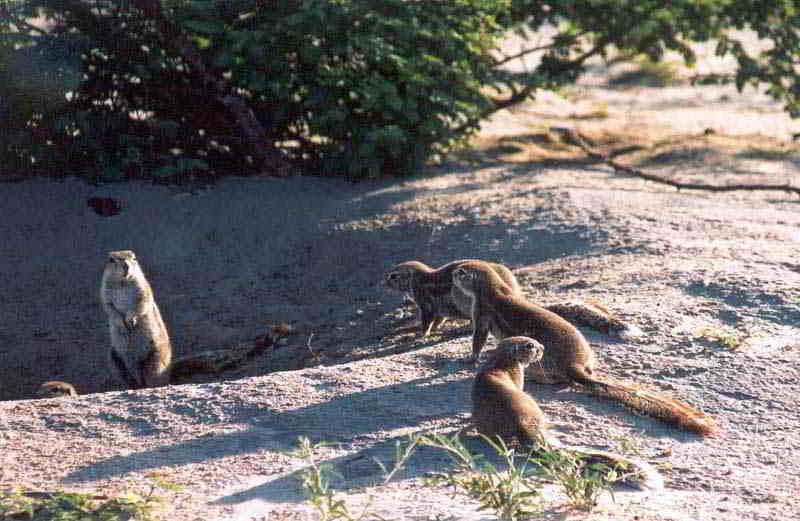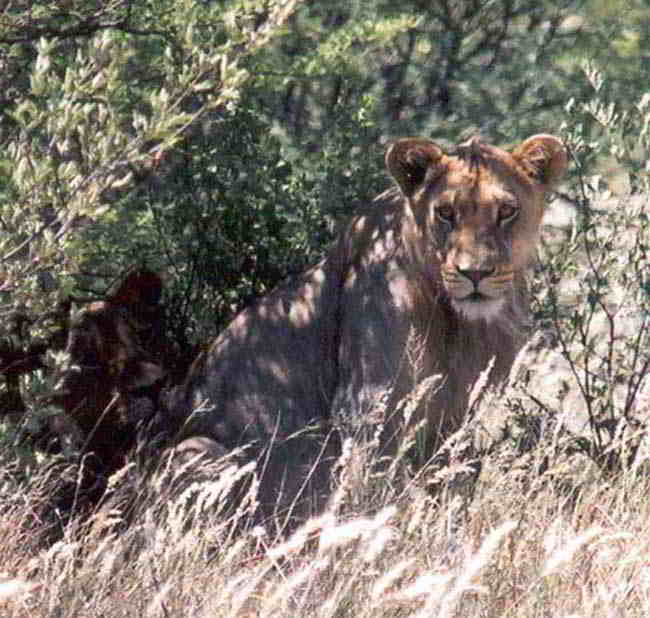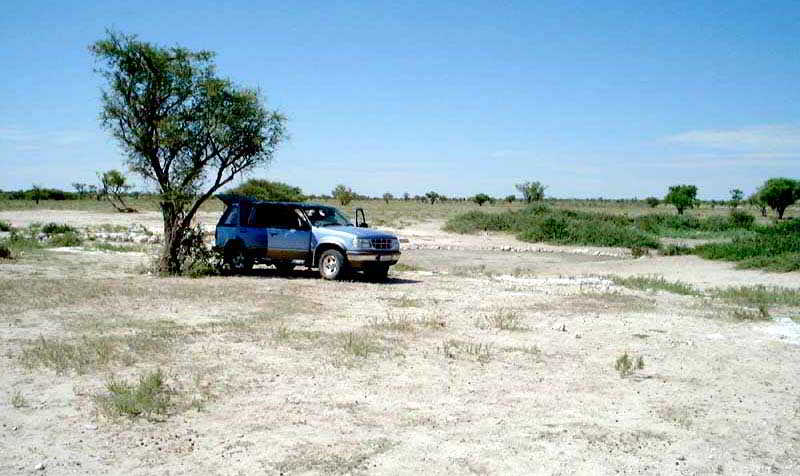Off to the Kalahari!
The decision had been made to visit the Kalahari*, so we read and re-read our guidebook to check the route. The car was loaded with food and drink and we left our comfortable chalets at Mokolodi Game Reserve at midnight to start our 250 km trip to the Kalahari desert. A simple night drive we thought. How wrong could we be?
Our spirits were high as we sped along tarred roads in the dark, through towns with names like Molepelole (pronounced Moh-lee–pel-oh-lee. It sounds better in a car). But by the time we stumbled across the isolated and sleepy hamlet of Lethlakeng 120km later we were bored and tired.
Sand roads… everywhere
By sheer fluke, we spotted the green sign at the roundabout directing us to Khutse down a side road. Confirmation of our destination briefly revitalised us until we felt the car juddering. With the night as black as Hades, our visible world shrunk to the narrow beam of the headlights. But they threw enough light to see we were now driving on a rutted road of hard gravel.
If the tarred road to Lethlakeng had been boring, the gravel road was mind-numbing. Shame it didn’t have the same effect on our jolted bodies. Driving on a featureless, dead-straight track for kilometre after kilometre at a constant speed in the dark proved so soporific that, despite the discomfort, the ladies quickly fell asleep followed minutes later by Dave.
An hour after leaving Lethlakeng the monotony was temporarily broken by a handful of huts, but my concentration had drifted. Just past the huts, a choice of forks in the road appeared, and I picked what seemed the most travelled.
After a while, the juddering stopped. In the full headlights I could see the road had narrowed but pressed on, regardless. Soon the steering felt a little sluggish, but nothing obvious. A change in engine noise and the motion of the car woke everyone. Something was not right.
I stopped the car and we all piled out only to discover we were standing in sand. This was as unexpected as it was unwelcome.
‘Where are we?’ Lesley asked. Good question.
Lost without a clue
My Garmin GPS was loaded with the coordinates for Khutse and had shown the tar roads to Lethlakeng but now – nothing. Just a blank screen with a black dot marking our intended destination somewhere to the northeast. Totally useless on a maze of sand tracks at night.
Apparently, I had turned off the ‘main’ road at one of the forks. But how far back? Dave and I walked along the track a few hundred metres using torches but saw nowhere I could turn the car around without sinking into the softer sand of the verge.
We were now lost on the edge of the Kalahari in the middle of the night. Even if we could have thought of someone to call, our cell phones had no signal. The ladies wanted to wait for daylight and then find our way back. Dave and I opted to continue our journey, engaging the 4×4 gears. The car slithered from side to side as it crept forward.
After what seemed like hours, we crawled around a bend – and were reunited with the main gravel track. A huge sigh of relief from one and all!

It’s at times like this that things change in the blink of an eye. One minute you’re the idiot responsible for losing everyone in the desert. The next you’re hailed as saviour and ‘Driver of the Year’ for your off-road skills. Fickle.
Compared to what we had been driving on, the gravel road felt like a motorway. Even the annoying ruts were welcome.
We arrived with the dawn
A grey line slowly crept along the horizon to announce sunrise. The dashboard clock displayed 5.30am. According to the GPS, we had crossed the Tropic of Capricorn recently but no one had noticed. What cheered us was how close we were to the black dot on the GPS that marked the entrance to the Khutse Game Reserve.
The sky erupted into a beautiful Botswanan sunrise as we reached the gates. Having made it to our destination, and with the sun crawling up the sky, we were in a better mood. We fell out of the car, stiff and tired. In Khutse there are no shops, no petrol, and no water. Nothing. But they did have toilets. That was a relief.

As we paid the entrance fee to the reserve, the helpful staff warned us against driving to several of the salt pans due to the treacherously soft sandy roads. We didn’t need telling twice.
A new concern was petrol. We only had about 180km of fuel remaining. Our tank was full when we left Mokolodi, with a range of about 600km, so it was surprising to see it so low. The 4×4 driving on soft sand had taken its toll on our fuel.
The staff confirmed it was about 100km back to Lethlakeng where there was petrol, and roughly 30km to the nearest salt pan and back. Fuel to spare, I declared in the car. Not everyone shared my confidence but after the long drive there was no way we weren’t going to see the salt pan.
The scenery in the Kalahari was mixed. Some areas were thick scrub, with flourishing bushes and long grass. Others, vast open expanses of white sand, dotted with small grassy tussocks, which disappeared into the distant heat haze.
But where were the animals?
Strange lack of animals
Khutse Game Reserve covers more than 2,500 square kilometres, so the animals can wander freely over an immense area. Consequently, they are harder to spot than in the smaller conventional game reserves we were used to. We did see individual gemsbok among the bushes and a solitary giraffe leering down at us as we drove by. But the hoped-for huge herds of antelope were nowhere to be seen. As was almost anything with four legs.

We parked under a large acacia tree at the Khutse salt pan and soaked in the scenery. A herd of springbok appeared but moved off as we left the car. Huge flocks of small birds swarmed in clouds in and out of the distant bushes.
Yippee! We were in the Kalahari! It was a unique feeling to stand in the open vastness and experience the intense desert heat, even without herds of antelope. After a snack and a leg stretch, we all needed a toilet.
Lesley remembered we’d passed a campsite a few kilometres earlier, so we returned hoping to find toilets. The place was deserted, but I spied a small ugly structure that had the unmistakable look of a loo. We pulled up nearby, but the loo turned out to be a dark and unappealing pit latrine. Desperate as they were, the ladies opted to remain in the car.
Spotting a convenient bush that was more tempting I jumped from the car to do what I needed.
No laughing matter
I had barely covered ten metres, about half the distance from the car, when a shadow under the bush moved. A big shadow. I froze. The shadow morphed into a large lioness and my heart stopped.

I suddenly felt very alone. The lioness sat upright and stared at me. What are you meant to do when confronted with a lion in the desert? Is it run or stand still? I didn’t care.
I backed away slowly, then turned and bolted as fast as I could. With every terror-filled step I thought I could feel her hot breath and expected large fangs to chomp into my legs. I threw myself into the car and slammed the door.
To the sound of laughter.
How could my companions be so dismissive of my close encounter with death? I looked out the window, expecting to see the lioness ready to pounce. But she wasn’t there. Dave pointed to the bush she had never left. Apparently, I was not on the menu.
The lioness yawned and dropped from sight back into the shadows under the bush. Presumably to wait and have fun when the next car pulled up for the toilet.
Still shaking, I decided our time in the Kalahari was at an end. I had no intention of getting out the car again in the near future. We needed to make our way back to Mokolodi in daylight and hope that the petrol would get us as far as the Shell station at Lethlakeng.
Quicker in daylight
Fortunately, it did. With the warning light blinking, we pulled into the petrol station and filled up. In daylight Lethlakeng looked very different. It was still small, sleepy and isolated. But now, stray donkeys stood in the middle of the road daring us to hit them, goats scrabbled for food on the verges and children ran everywhere.
The return journey to Mokolodi was, as the guidebook suggested, about four hours. Compared to our outbound journey, the ride back on the tarred road was delightfully dull. That night we collapsed into the comfortable beds of our Mokolodi chalets and slept the sleep of the dead. Late the next morning we set off for home in Johannesburg. We were exhausted but chuffed we had achieved our goal of seeing the awesome Kalahari.
In hindsight, it was absurd to try to ‘do’ the Kalahari in half a day but I’m glad we did. We saw a few animals – one far too close for comfort – but not many. But then that’s the charm of the place. It’s an enormous, authentic wilderness. Not a zoo.
It might be big but it’s hard to find it at night.

*(Please read Unexpected encounters in Botswana for the background to this adventure).
More information about the Kalahari
https://www.namibweb.com/khutsereserve.htm (good directions)
https://www.botswanatourism.co.bw/
https://en.wikipedia.org/wiki/Khutse_Game_Reserve
https://www.botswanabeckons.com/places/places-western-botswana/item/khutse-game-reserve

One thought on “The Kalahari Desert – Don’t try this at night”